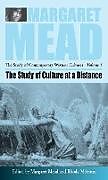The Study of Culture At a Distance
Einband:
Fester Einband
EAN:
9781571812155
Untertitel:
Englisch
Genre:
Sozialwissenschaften allgemein
Herausgeber:
Ingram Publishers Services
Anzahl Seiten:
560
Erscheinungsdatum:
01.07.2000
ISBN:
978-1-57181-215-5
Autorentext
Margaret Mead served as Curator of Ethnology at the American Museum of Natural History from 1925 to 1969. She began her career with a study of youth and adolescence in Samoan society, published as Coming of Age in Samoa (1928). She published prolifically, becoming a seminal figure in anthropology, and was posthumously awarded the Presidential Medal of Freedom in 1979.
Klappentext
The United States on the eve of the Second World War was still a society largely isolated from the world. Facing enemies with unfamiliar cultural traditions, the U.S. government turned to anthropologists for insight. The result was a research effort that continued long after the war, aimed, in the words of Margaret Mead, at analyzing the cultural regularities in the characters of individuals who are members of societies that are inaccessible to direct observation. In 1953, Margaret Mead and Rhoda Métraux produced The Study of Culture at a Distance, a compilation of research from this period. This remarkable work, long unavailable, presents a rich and complex methodology for the study of cultures through literature, film, informant interviews, focus groups, and projective techniques. The book also provides fascinating insights into such diverse cultures as China, Thailand, Italy, Syria, France, Germany, Russia, Romania, and Great Britain, and includes some highly original analysis such as that of the Soviet style of chess, a study of Jean Cocteau's classic film La Belle et la Bête, and the cultural interpretations of Rorschach tests administered to Chinese subjects.
Inhalt
Preface Introduction PART I: INTRODUCTION The Study of Culture at a Distance
Margaret Mead Chapter 1. The Purpose and Scope of This Manual
Chapter 2. The Needed Skills and Their Place in Cultural Analysis Chapter 3. Theory and Practice Theory and Methods Derived from Anthropology Theory and Methods Derived from Other Disciplines Chapter 4. Anthropological Models for the Study of Culture at a Distance The Single Informant The Study of Living Communities PART II: NATIONAL CHARACTER National Character: Theory and Practice
Geoffrey Gorer PART III: GROUP RESEARCH A: The Organization of Group Research
Margaret Mead B: Five Illustrations of Groups at Work Introduction
Rhoda Métraux Chapter 1. Formulation of a Working Hypothesis: French Dyadic Relationships
Chapter 2. Formulation of a Working Hypothesis: The Swaddling Hypothesis Chapter 3. Intragroup Interviewing: On thc Definition of Terms The Chinese First Teacher Sincerity Chapter 4. Relations between Men and Women: Has the Woman a Soul? The Position of the Woman Woman's Position Redefined Chapter 5. Themes in Italian Culture: A First Discussion PART IV: WORK WITH INFORMANTS A: Informants in Group Research
Rhoda Métraux B: Three Illustrations of Written Work by Informants I. Polish Personality Does Responsibility Mean Command? Attitudes toward Various Parts of the Body When Is a Pole Allowed to Be Soft? II. My Inner Self III. Russian Sensory Images On the Sense of Touch On the Sense of Smell On the Sense of Hearing C: Ten Illustrations of Interviews with Informants I: Interview with a Syrian Woman: Life History
II: Interview with a Syrian Man: Life History
III: Interview with a Polish Peasant Woman: Parents and Children
IV: Interview with a French Couple: Dyadic Relations in the Foyer
V: nterview with a Young Frenchman: Friendship
VI: Interview with a Chinese Scholar: Friendship
VII: Interview with Two Jewish Men: Sheyneh and Prosteh Yiden
VIII: Interview with Two Jewish Women: Sheyneh and Prosteh Yiden
IX: Interview with a Russian Actor: Interpretation of Roles
X: Interview with Four Russians: Images of Hate, Guilt, and Love
PART V: WRITTEN AND ORAL LITERATURE Introduction
Rhoda Métraux Chapter 1. Relations between Men and Women in Chinese Stories
Virginia Heyer Chapter 2. The Image of the Leader in Soviet Post-October Folklore
Nelly Schargo Hoyt Chapter 3. A Russian Double Image Cluster: Not-So: So The Not-So: So Images in Russian Folklore
Nelly Schargo Hoyt Rumor Cluster and Image Cluster: Detail from Group Discussion Russian Visual Thinking
Leopold H. Haimson Chapter 4. Trends in Affectlessness
Nathan Leites PART VI: FILM ANALYSIS A: Movie Analysis in the Study of Culture
Martha Wolfenstein B: Five Illustrations of Film Analysis Introduction
Rhoda Métraux I: Notes on an Italian Film, The Tragic Hunt
Martha Wolfenstein II: Notes on Two French Films The Father Figure in Panique
Jane Belo Notes on La Belle et La Bête
Geoffrey Gorer III: An Analysis of Seven Cantonese Films
John Hast Weakland IV: An Analysis of the Soviet Film The Young Guard Plot Summary
Margaret Mead Comparison of the Film and the Novel
Vera Schwarz (Alexandrova) V: An Analysis of the Nazi Film Hltlerjunge Quex
Gregory Bateson PART VII: PROJECTIVE TESTS A: The Use of Projective Tests in Group Research
Margaret Mead B: Two Illustrations of the Use of Projective Tests with Chinese Subjects Visual Perception and Spatial Organization: A Study of Performance on the Horn-Hellersberg Test by Chinese Subjects
Elisabeth F. Hellersberg Some Aspects of Personality of Chinese as Revealed by the Rorschach Test
Theodora M. Abel and Francis L. K. Hsu PART VIII: IMAGERY Resonance in Imagery
Rhode Métraux PART IX: END LINKAGE: AN ANALYTICAL APPROACH A: History of the Approach
Margaret Mead B: Formulation of End Linkage
Gregory Bateson C: Four Applications of End Linkage Analysis Applications of End Linkage Formulations to Anglo-American Relations in World War II
Margaret Mead Male Dominance in Thai Culture
Ruth Benedict Non-Reciprocity among East…

Leider konnten wir für diesen Artikel keine Preise ermitteln ...
billigbuch.ch sucht jetzt für Sie die besten Angebote ...
Die aktuellen Verkaufspreise von 6 Onlineshops werden in Realtime abgefragt.
Sie können das gewünschte Produkt anschliessend direkt beim Anbieter Ihrer Wahl bestellen.
Loading...
Die aktuellen Verkaufspreise von 6 Onlineshops werden in Realtime abgefragt.
Sie können das gewünschte Produkt anschliessend direkt beim Anbieter Ihrer Wahl bestellen.
| # | Onlineshop | Preis CHF | Versand CHF | Total CHF | ||
|---|---|---|---|---|---|---|
| 1 | Seller | 0.00 | 0.00 | 0.00 |
